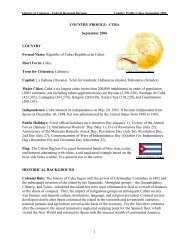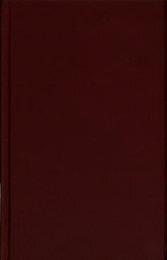Anton Webern's Six Pieces for Ocrhestra, op. 6, Arrangement for ...
Anton Webern's Six Pieces for Ocrhestra, op. 6, Arrangement for ...
Anton Webern's Six Pieces for Ocrhestra, op. 6, Arrangement for ...
Create successful ePaper yourself
Turn your PDF publications into a flip-book with our unique Google optimized e-Paper software.
7 This piano transcription, made in 1918, was per<strong>for</strong>med in the Verein on February 16,<br />
1919.<br />
8 In addition, Webern had been asked during the fall of 1921, a short time be<strong>for</strong>e the<br />
Verein went out of existence, to arrange Mahler's Lied von der Erde and Debussy's Prélude<br />
à l'après-midi d'un faune. Cf. his letter of September 22, 1921, to Heinrich Jalowetz:<br />
Heinrich Jalowetz Collection, Paul Sacher Foundation. However, the Mahler arrangement<br />
was finally begun (but not completed) by Arnold Schoenberg, while the chamber version<br />
of Debussy's piece was carried out by Benno Sachs.<br />
9 Until very recently, the surviving source material had not been collected and identified<br />
systematically, and not even all the concert programs of the Verein were known with<br />
certainty. Thus, <strong>for</strong> example, Hans Moldenhauer could not provide any in<strong>for</strong>mation as to<br />
whether the chamber version of <strong>Webern's</strong> <strong>op</strong>. 6 was ever per<strong>for</strong>med or how much work<br />
Webern had actually done on his arrangement of Schoenberg's Four Songs, <strong>op</strong>. 22 (see<br />
Moldenhauer, <strong>Anton</strong> von Webern [cf. note 6], pp. 129 and 229). The <strong>for</strong>mer question has<br />
meanwhile been solved (see above), while all we can say about the latter is that Webern<br />
completed the arrangement of at least the first of the Schoenberg songs, as can be seen<br />
from his letter to Heinrich Jalowetz of September 22, 1921 (Heinrich Jalowetz Collection,<br />
Paul Sacher Foundation).<br />
10 This is indicated in Haugan's letter of November 9, 1993, to this writer. The score<br />
published by Universal Edition (UE 14778, with a c<strong>op</strong>yright date of 1977) does not give an<br />
editor's name.<br />
11 Cues are to be found in measure 18 of No. 2 (in the parts <strong>for</strong> oboe and clarinet), in<br />
measure 4 of No. 3 (in the part <strong>for</strong> drum), and in measure 11 of No. 5 (in the parts <strong>for</strong> flute,<br />
harmonium, and piano). It was Friedrich Cerha, the conductor of the ensemble die reihe,<br />
who provided Universal Edition with a reconstructed double bass part (conversation with<br />
Friedrich Cerha, March 7, 1994).<br />
12 The repeated eighth notes are here given to the drum part.<br />
13 These are marked in Haugan's reconstructed score.<br />
14 In his letter of September 21, 1921, Webern wrote to Heinrich Jalowetz, "I cannot help<br />
thinking that my conducting of the Orchestral <strong>Pieces</strong>, which you saw and heard this year,<br />
has not made a very favorable impression upon you. Doubtless you are right!" (Heinrich<br />
Jalowetz Collection, Paul Sacher Foundation.)<br />
15 The full title of this first edition reads: "Sechs Stücke/für grosses Orchester/von/<strong>Anton</strong><br />
von Webern/Op. 4/Im Selbstverlag des Komponisten" [Vienna, 1913]. In 1961 it became<br />
available as a study score issued by Universal Edition (Philharmonia Scores No. 433). The<br />
work was not given its final designation "<strong>op</strong>. 6" until 1920.<br />
16 See the recent article by Gösta Neuwirth, with extensive press documentation, "Kehraus<br />
des schönen Wahns," in Aufbruch in unsere Welt: Essays zu Kunst, Musik, Literatur und<br />
Architektur (Vienna: Löcker, 1993), pp. 60-97.



![Albert Einstein Papers [finding aid]. Library of Congress. [PDF ...](https://img.yumpu.com/21604228/1/190x245/albert-einstein-papers-finding-aid-library-of-congress-pdf-.jpg?quality=85)





![American Colony in Jerusalem Collection [finding aid]. Library of ...](https://img.yumpu.com/17941275/1/190x245/american-colony-in-jerusalem-collection-finding-aid-library-of-.jpg?quality=85)



![Piccard Family Papers [finding aid]. - American Memory - Library of ...](https://img.yumpu.com/17941234/1/190x245/piccard-family-papers-finding-aid-american-memory-library-of-.jpg?quality=85)


